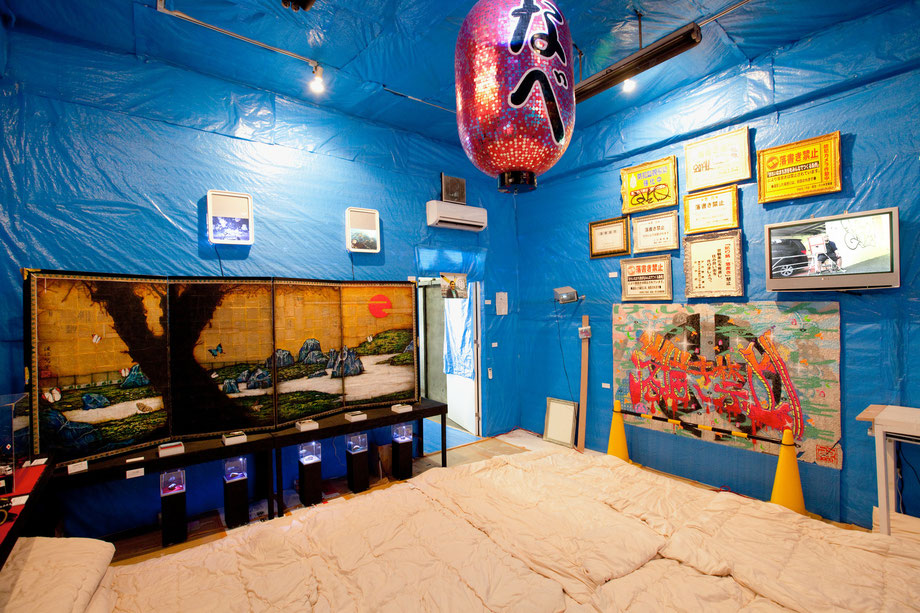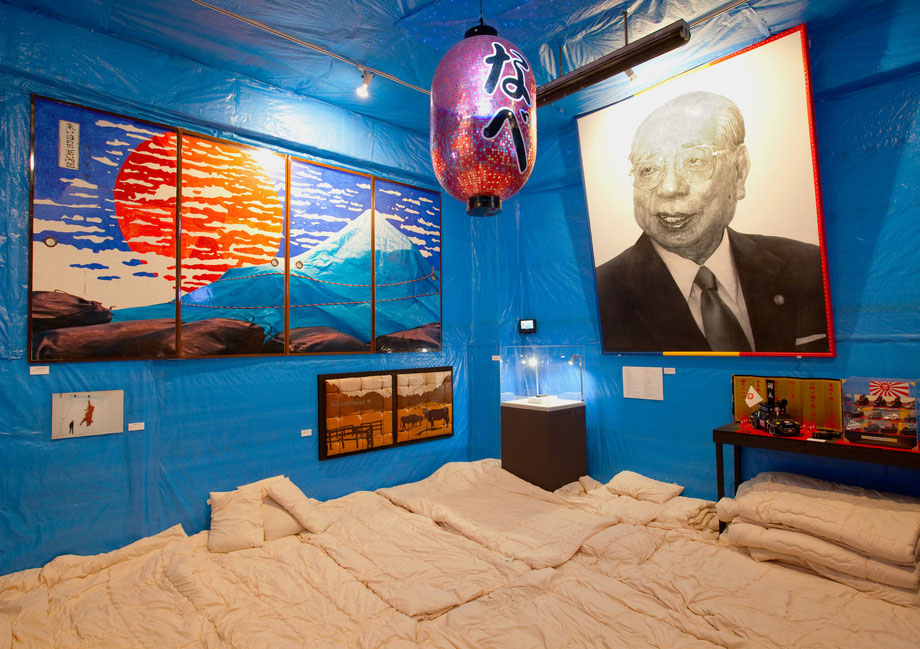W O R K S
Solo Exhibition "Yosenabe Hot Pot"
2014
At Art Lab AKIBA

"Yosenabe Hot Pot" DM, 2014
"Yosenabe Hot Pot" Trailer, 2014, (Japanese Only)
[Overview of Solo Exhibition "Yosenabe HotPot"]
Exhibition period: June 28(Sat), 2014 - July 19(Sat)
Admission: Free (some events charge an entry fee)
Venue: Art Lab AKIBA
Director: Yoshinori Tsukuda
Cooperation: Futon Festival Committee
<During the event>
June 28 (Sat) "Opening Reception"
July 4 (Fri) "Round-table discussion at the tarp house"
Guest: Makoto Aida, Junichiro Take
July 12 (Sat) "Evening to Love the Lantern Mirror Ball"
Live: Kenichiro Toma
[Statement]
During the three years between 2010 and 2013, I wasn't able to work publicly due to my depression and social withdrawal as a hikikomori; I was on a hiatus. In the meantime, I drew portraits commissioned by friends and helped out Makoto Aida's and Chim↑Pom's exhibitions every so often.
In 2013 I fully recovered and resumed working. However, many people who started viewing my work from that point may not be familiar with the work I presented before my hiatus because of the years between; some include important and essential work in expressing my background or ideas.
By holding one forward-looking retrospective with Yosenabe Hot Pot, I present an overview of my work from pre-hiatus onwards to show who I am as an artist, creating an opportunity to move towards the next step.
--Atsushi Watanabe
[Commentary]
Atsushi Watanabe was in a state of depression from 2010 to 2013 and thus was in no state to create art. He recovered last year (2013) and resumed his career, but as he had not showed his previous works to the public, it was decided that both his new and old works will be shown at the same time in this “Solo Exhibition "Yosenabe Hot Pot” However, even as he was struggling with creating his art, Watanabe was participating in activities such as painting commissioned portraits, assisting Makoto Aida with his works and supporting exhibitions held by Chim↑pom. When he was styding at Tokyo University of the Arts, he would also help Masato Nakamura with his work.
Watanabe’s works are based off art theory by Andy Warhol and the like, as well as information found on media. His most controversial work, the portrait of Daisaku Ikeda Lives of Great Men of the World (3) (2007) was created as a graduating thesis for the Tokyo University of the Arts, exhibited at the thesis show and became a topic of public concern and debate at the time. The March 17, 2007 volume of “Shukan Gendai” covered this work, with the headline “Satire, Worship, Or…? Controversy at the University” The reason Watanabe painted a portrait of this celebrity was because his father, along with other relatives were extremely devout to a religious group that venerates this figure as an icon. Ikeda was a familiar figure since Watanabe’s childhood.
Watanabe’s works, no matter how they are interpreted, are significant in the meanings behind the paintings and sculptures which are portrayed in a unique way. He claims he is not interested in work which merely portrays the subject. What is important is the meaning behind why the work was created. Marcel Duchamp once said, “Say there is a man that portrayed 50 Campbell Soups on a canvas. What is the issue here is not the image that is reflected onto the retina, but rather the concept held by the man who had to portray 50 of those cans.” (From Marcel Duchamp Samuel A. Green : Andy Warhol [ The New Art ]) In that way, Watanabe’s philosophy could be said to be derived from a Duchamp method of thinking.
Watanabe, upon seeing Makoto Aida’s art collection book titled “Lonely Planet” while he was in prep school for art, said he was shocked by the commentary of those works. From then, Watanabe believed that the commentary of the work by Aida himself demonstrated Aida’s conceptual art style more than the works themselves, and started adding commentary to each of his works as well. He said he was also influenced by Damien Hirst from abroad.
The work Shibuya: Blue Tearoom in Dry Landscape Garden Folding Screen (2013) at first glance resembles Japanese art on folding screens with gold leaves plastered onto the surface, but the part that looks like a stone garden is actually a group of homeless tents made with blue sheets (Watanabe, for half the year of 2010, lived with the homeless inside Miyashita Park). The golden screen style material is also actually cardboard boxes collected in Shibuya. This work was exhibited at a Shibuya department store’s art gallery, because Watanabe wanted to compare the image of homeless people of Shibuya who suffer from the depths of poverty with an art gallery at a department store which handles extremely valuable artworks. Watanabe has also been a part of a meeting body called the ”246 Artist Conference”, and has fought against a famous large corporation in relation to this organization.
There are also works such as “Tokyo University of the Arts propaganda Truck” and “Booger Gold Bars” in the exhibit. These works attempt to question society’s power structure and the money-worshipping concept of “richness.”
In this gallery, Watanabe hangs a large mirror ball-style lamp that has “NABE” written in the center of the hall and covers the entire space with blue sheets, transforming an uppity space of fine art into a cheap, club-like environment. He brings about a new perspective of the established belief that the gallery itself represents the world of art with an added twist.
Although dealing with social issues surrounding the artists’ own lives and surroundings is often perceived as domestic due to its familiarity, when the fundamental reasoning behind the work is its relevance in society and visualizing phenomena that cannot easily be covered up, the work encapsulates the standards of world art history. The way that Watanabe stands between the interaction point between Japanese contemporary art and contemporary art in the world, both the influences of Damien Hirst and Makoto Aida can be observed.
--Taisuke Morishita|Art critic

Installation view: "Yosenabe Hot Pot" 2014/ Photography: Jin Koyama

Installation view: "Yosenabe Hot Pot" 2014/ Photography: Jin Koyama
[List of Exhibits]
1, No Graffiti: Promoting Landscape Beautification
2013-2014
Installation, Cutting out the outer wall of Atsushi Watanabe's studio and exhibiting it at the gallery
Mortar wall, spray, paint, surveillance camera type monitor
- Mortar wall size: 130×195(cm)
- Vide: Shooting: Atsushi Watanabe, Music: DJIbutsu、Editing cooperation: Noboru Kamata(5min. 32sec. | loop)
Private Collection
Fron 2013 onwards
Paintings (canvas, enamel paint, crylic paint, picture frame), video (2013-2014)
Paintings: 59.0 × 49.5 (cm) Including framing etc. / Video (6min. 30sec. | loop) Shooting: Noboru Kamada, sound: Himajin
3, Shibuya: Blue Tearoom in Dry Landscape Garden Folding Screen
2013
Four panel folding screen
Cardboards picked up at Shibuya, empty cans, old newspaper, acrylic paint, others
131.7×312.0(cm)
4, Shibuya: Blue Tearoom in Dry Landscape Garden (Circular Window)
2013
Cardboards picked up at Shibuya, empty cans, acrylic paint, acrylic plate
53×53(cm)
Private collection
2009
*Document photography of the same title installation work (2009)
Edition: 30
6. The Corpse Abandonment Incident ~Leather~
2008
Disassemble the discarded leather products and re-suture
74×69 (cm) for both left and right
2007
Two years worth of Atsushi Watanabe’s boogers, a replica of the exhibition stand at Bank of Japan, video (1 min. 25 sec. | looped)
Private Collection
8. Lives of Great Men of the World (3)
2007
Canvas, oil paint, oil pastel, self made picture frame, bibliography panel, research file
233.6×187.3(cm)
9, "River" series
2001, 2014
Photography, picture frame, LED)
10, Pikachu ~ Pokémon's monster ~ (angry performance)
2008, 2014
Photography, metal fittings
30.5 × 38.8 (cm)
11, Vermillion Sunrise Blue Containment
2014
Four sliding fuses
Acrylic paint, digital print, sliding door
175.9 × 359.6 (cm)
12, Just a stone (depiction example)
2009, 2013
Hand drawn synthesis.
Photographic paper , acrylic paint , display stand
Photography size; 9.0×12.8(cm)/ Base size: 15.0×15.0(cm)
13, Just a Stone (installation example)
2009, 2013
stone, self-made display stand (acrylic box, wood, LED light, wiring code etc.)
Base size: 15.0×15.0×53.6(cm)
14, Fatman (NABE lantern 2014)
2014
PVC, polystyrene foam, rotary motor, paint
130 × 60 × 60 (cm)
15, Tokyo University of the Arts 122 year anniversary goods
2009
RC, acrylic paint, plastic, wire, sticker, speaker
(Sound source: a parody "Ueno no Sakura" , 59 sec. )
ーーーーーーーGoodsーーーーーーー
16, Tokyo University of the Arts 120 year anniversary goods
2007
Minicar, acrylic paint, plastic, wire, others
Edition: 120
17, No graffiti sticker: ”Let's put a sticker in a place I should not do graffiti”
Color large 1 / small monochrome 8 set
18, NABE lantern cookie
19, Original Badge
20, Watanabe Atsushi art collection book"WATANABE"
(Postponement release)
"Round-table discussion at the tarp house"
An event in the solo exhibition "Yosenabe Hot Pot".
Dates: July 4 (Fri)
Hours 19:00-20:00
Progression: Atsushi Watanabe
Guest: Makoto Aida, Junichiro Take
Language: Japanese Only
Talk event to talk about past works by three people with common items such as "homeless" and "cardboard house".
Also about Atsushi Watanabe's work explanation and encounter with the guests.
"Evening to Love the Lantern Mirror Ball"
An event in the solo exhibition "Yosenabe Hot Pot".
Dates: July 12 (Sat)
Hours: 20:00-22:00
Live: Kenichiro Toma
DJ event which used the new work Fatman (NABE lantern 2014) of the mirror ball type by dropping the lighting of the exhibition hall.
[Production Support/ Event]
Junsai Uetake, Kai Takeda, Osamu Matsuda, AndyFazKawasaki, Hiroyuki Kajima, Sayuri Yamanaka, Noboru Kamata, Akane Enda, Takuya Nakayama, Muraku Waraku, Shizuka Sato, Takehiro Nakagawa, Erika Fukami, Keiko Kurata, Yuta Watanabe, Takashi Sakurai, Hikaru Miyakawa, Kana Taniguchi, Kimiaki Sugiki
[Photography]
Jin Koyama
[Organizer]
Art Lab AKIBA
[Director]
Yoshinori Tsukuda
[Guests]
Makoto Aida, Junichiro Take, Kenichiro Toma
[Cooperation]
Futon festival executive committee









